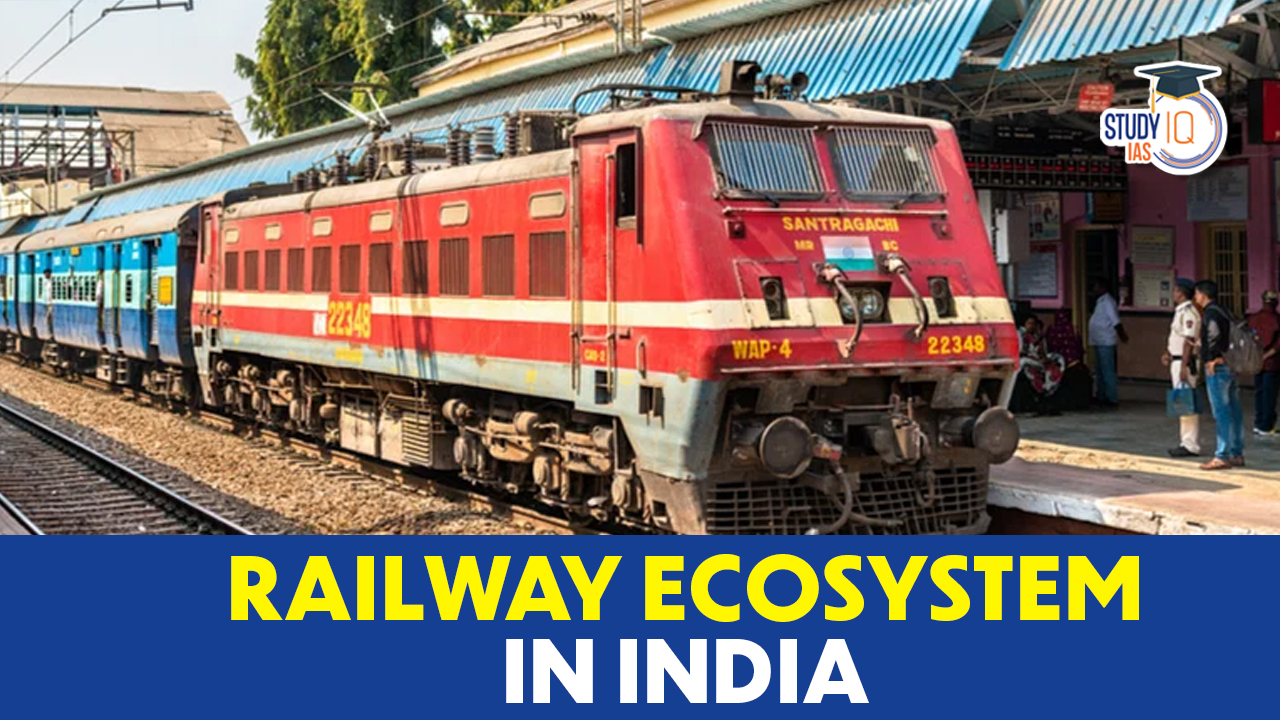Table of Contents
Context: The recent collision in Balasore, Odisha between two express passenger trains and a stopped freight train, has been observed to be the deadliest Odisha train accident on record in the last 20 years. In this article, you will all about the Railway Ecosystem in India, its Growth, Significance and Contribution to the Indian Economy.
Odisha Train Accident
- The Odisha train accident resulted in 275 fatalities and more than 1,000 injuries.
- CBI investigation is on in the Odisha train accident as the reason for the Odisha train accident is still not clear.
- The last train accident with so many fatalities occurred in Tanzania in 2002, when a passenger train and a freight train collided on a hill railway, leaving 281 people dead.
Read More: Andhra Train Accident
Railway Ecosystem in India
Indian Railways is the largest rail network in Asia and the world’s second-largest railway system under a single management.
- Network: Indian Railways has an extensive network spanning over 67,000 km and operating across more than 7,000 stations.
- Employees: With a workforce of over 1.4 million employees, Indian Railways ranks among the largest employers globally and is the eighth largest employer in India.
- Passengers: Every day, Indian Railways carries an astounding number of over 23 million passengers, which is equivalent to the population of Australia. In a year, it transports more than 8 billion passengers, surpassing the population of the entire world.
- Freight: Indian Railways handles an impressive amount of freight, moving over 3 million tonnes each day, equivalent to relocating the entire population of Mumbai daily. Annually, it transports more than 1 billion tonnes of freight.
- Revenue: Indian Railways serves as a major revenue generator for the Indian government. In the fiscal year 2019-20, it generated revenue exceeding INR 1.9 trillion (approximately USD 25 billion).
- Technology: Indian Railways has implemented numerous technological advancements in recent times. These include GPS-based train tracking, an online reservation system, and the introduction of bio-toilets in trains.
- Heritage: Indian Railways boasts a rich heritage, with some of its trains and stations dating back over a century. Notably, the Darjeeling Himalayan Railway and the Nilgiri Mountain Railway have been recognized as UNESCO World Heritage Sites.
Significance and Growth of Indian Railways
- Enhanced Passenger Transport: Railways provide the most affordable and convenient mode of transport for both long-distance and suburban travel. They offer a reliable means of transportation for millions of passengers, facilitating connectivity across the country.
- Driving Industrial Growth: Railways have played a significant role in the development and growth of industries in various regions. The establishment of railway networks in areas such as Mumbai for the textile industry, Kolkata for the jute industry, and Jharkhand for the coal industry has contributed to their expansion. Railways enable the transportation of raw materials and finished goods, supporting the functioning of industries and their supply chains.
- Catalyzing Agricultural Growth: Railways have been instrumental in promoting the commercialization of agriculture. Farmers can now sell their produce to distant places and even access international markets, thanks to the efficient transportation provided by railways. This has facilitated the growth of agriculture and improved farmers’ access to remunerative prices for their products.
- Connecting Rural Areas and Disseminating Innovations: Railways bridge the gap between cities and rural areas, reducing isolation and facilitating the dissemination of innovations and new ideas. They play a vital role in connecting different parts of the country, promoting cultural exchange, and fostering overall development.
- Stimulating National Market and International Trade: Railways contribute to the national market by promoting the equalization of prices across regions. They are connected to major ports, facilitating international trade and enhancing the country’s economic integration with the global market.
- Supporting Defence and Internal Security: Railways play a crucial role in national defence and internal security. They ensure the swift movement of troops, defence equipment, and essential supplies to remote locations, bolstering the country’s defence capabilities.
- Mitigating Natural Calamities and Providing Relief: During times of natural calamities such as droughts, floods, famines, and earthquakes, railways are pivotal in providing relief and aid. They transport rescue teams, essential supplies, and humanitarian assistance to affected areas, helping save lives and alleviate suffering.
- Boosting Tourism: Indian Railways significantly contributes to the tourism industry, offering various heritage and luxury train experiences. Connecting multiple tourist destinations, facilitates convenient travel within the country, providing tourists with a unique and enriching exploration experience.
- Promoting National Integration: Indian Railways plays a vital role in fostering national integration by establishing connections between different regions and facilitating the movement of people across state boundaries. It promotes cultural exchange, and unity in diversity, and strengthens the social fabric of the nation.
Growth and Development of Indian Railways
- Historical Milestones: The first railway line in India, between Mumbai and Thane, was opened to the public on April 16, 1853. Subsequently, various railway lines were constructed, connecting important cities across the country.
- Expanding Network: With a vast network of 6,906 stations and a route length of 63,122 km, Indian Railways operates in diverse terrains, including challenging ones like the Jammu-Udhampur route and the Konkan railway route.
- Government Undertaking and Employment: Indian Railways is the largest public sector undertaking in the country and serves as the largest employer, with over 10 lakh employees working across operational and commercial sections of the railways.
- Statistics: Indian Railways comprises a fleet of 7,681 locomotives, 39,852 passenger service vehicles, 4,904 other coaching vehicles, and 2,14,760 wagons. It covers the longest rail route in India, from Dibrugarh in Assam to Kanyakumari in Tamil Nadu.
Challenges and Shortcomings
- Capacity Constraints: The high volume of passengers and freight transported daily leads to overcrowding and delays, impacting the efficiency of operations.
- Safety Concerns: Safety is a significant challenge for Indian Railways. The network has experienced a significant number of accidents and incidents, including train derailments, resulting in fatalities and injuries. Ensuring passenger and crew safety remains a top priority.
- Infrastructure Upgradation: The existing infrastructure of Indian Railways, including tracks, stations, and signaling systems, requires modernization and upgradation. Aging infrastructure hampers smooth operations and the ability to meet the growing demand for transportation services.
- Funding Constraints: Indian Railways faces financial challenges in funding infrastructure development and modernization projects. The cost of such projects is substantial, and securing adequate funds is essential. The Railways heavily rely on government funding and internal resources, which may limit the scope of investment.
- Competition from Other Modes of Transportation: Indian Railways faces competition from alternate modes of transportation, such as roadways and airways. Increasing competition in the freight and passenger transportation sectors poses challenges to maintaining market share and attracting customers.
- Skilled Human Resources: Indian Railways faces a shortage of skilled human resources, particularly in critical areas such as safety, maintenance, and operations. Filling vacancies with qualified personnel and providing appropriate training are crucial for efficient and safe railway operations.
CAG Report on Indian Railways
The CAG report highlighted several shortcomings in the safety of India’s railways including:
- Shortfalls in inspections: The report found that there were significant deficiencies in inspections conducted by Track Recording Cars, which are responsible for assessing the geometrical and structural conditions of railway tracks. The inspections were found to have shortfalls ranging from 30% to 100%.
- Failures to submit or accept inquiry reports: The report pointed out that there were failures to submit or accept inquiry reports after accidents. This hampers the process of learning from past mistakes and preventing recurrences of incidents.
- Inadequate use of dedicated railway fund: The report found that the dedicated railway fund, which is meant for priority tasks, was not effectively utilized. It highlighted failures to use the fund for essential safety-related activities.
- Decline in funding track renewal: The CAG report revealed a decline in funding for track renewal, which is crucial for maintaining the safety and integrity of railway tracks. Insufficient funding in this area can lead to track deterioration and increase the risk of derailments.
- Inadequate staffing in safety operations: The report identified inadequate staffing in safety operations as a serious concern. Insufficient manpower can affect the timely execution of safety-related tasks and compromise the overall safety of the railway system.
- Costs of derailments: The report estimated the costs of derailments to be around Rs 32.96 crore. This includes the financial impact of accidents across 16 railway zones and the associated damages and losses.
- Non-operational Track Management System (TMS): The TMS, a web-based application for online monitoring of track maintenance activities, was found to be non-operational. The in-built monitoring mechanism of the TMS portal was not functioning, and information related to the closure of inspection notes was not filled in the portal.
- Link between derailments and track renewals: The report stated that out of the 1,127 derailments that occurred during 2017-2021, around 289 derailments (26%) were linked to track renewals. This highlights the importance of adequate investment in track maintenance and renewal to prevent accidents.
Initiatives taken by the Government
The Indian government has launched several initiatives to boost the railways in India. Some of these initiatives include:
- Foreign Direct Investment (FDI): The government has allowed FDI in railways-related components, attracting foreign investment to the sector. From April 2000 to March 2020, FDI inflow in railways-related components stood at US$ 1,107.60 million.
- National Rail Plan: The government is working on a comprehensive “National Rail Plan” that aims to integrate the rail network with other modes of transport and develop a multi-modal transportation system in the country.
- New Online Vendor Registration System: The Research Designs & Standards Organisation (RDSO), the research arm of Indian Railways, has launched a digital and transparent system called the “New Online Vendor Registration System” to streamline vendor registration processes.
- Dedicated Freight Corridors (DFCs): The construction of dedicated freight corridors is underway to increase the proportion of freight traffic and improve the efficiency of goods transportation. The Western Dedicated Freight Corridor (WDFC) from Mumbai to Uttar Pradesh and the Eastern Dedicated Freight Corridor (EDFC) from Dankuni in West Bengal to Ludhiana in Punjab are part of this initiative.
- Rail Kisan: The “Rail Kisan” initiative aims to boost the transportation of agricultural goods by providing dedicated trains for farmers. Under this program, over 49,000 tonnes of goods have been transported on eight routes, benefiting farmers across the country.
- Program for the Redevelopment of Station Infrastructure: The government has launched a program to redevelop 400 railway stations across India under a public-private partnership (PPP) model. The aim is to create self-sustainable stations with high standards of safety, comfort, passenger amenities, value-added services, and efficiency.
- Connecting Mining Districts and the North East: Railway connectivity in the North East region is being improved to promote inclusive development. Broad gauge lines are being extended to connect major cities in the region, and railway connectivity to mining districts is being mapped to enhance transportation.
- Quest for Self-reliance: As part of the “Atma Nirbhar Bharat” initiative, the railways are implementing various projects. These include the development of the indigenous anti-collision system called “Kavach,” the introduction of highly energy-efficient “Vande Bharat” high-speed trains, and the goal of achieving zero accidents.
The KAVACH System
- ‘Kavach‘ literally means armour, is an indigenously developed Automatic Train Protection (ATP) system by Research Design and Standards Organisation (RDSO) in collaboration with the Indian industry.
- It is a set of electronic devices and Radio Frequency Identification devices (RFID) installed in locomotives, in the signalling system as well the tracks, that talk to each other using ultra-high radio frequencies to control the brakes of trains and also alert drivers, all based on the logic programmed into them.
- It is meant to provide protection by preventing trains from passing the signal at Danger (Red) and avoiding collision.
- It activates the train braking system automatically if the driver fails to control the train as per the speed restrictions.
- In addition, it prevents collisions between two Locomotives equipped with a functional KAVACH system.
- It is one of the cheapest, Safety Integrity Level 4 (SIL-4) certified technologies with a probability of error is 1 in 10,000 years.
Privatization of Indian Railways
The Indian Railways has taken a step towards privatization by allowing private firms to operate passenger trains on its network through the introduction of 151 new trains.
- While these trains will only make up a small portion of the overall railway network, it signifies the beginning of private sector participation in passenger train operations.
- The idea of privatizing the Indian railways has been recommended for many years, both by the former Planning Commission of India and now by Niti Aayog.
- The aim is to liberalize the entry of new operators into the public transport sector, which has traditionally been a government monopoly.
- This move is expected to improve services and facilitate the growth of the railway industry. However, the concept of privatization has its own advantages and disadvantages.
- The Bibek Debroy Committee, which was formed to suggest ways to mobilize resources for the Indian Railways and restructure the Railway Board, has recommended the privatization of rolling stock, such as wagons and coaches.
- The objectives of this privatization initiative are:
- To introduce modern technology rolling stock that requires reduced maintenance
- Reduce transit time
- Create job opportunities
- Enhance safety,
- Provide a world-class travel experience to passengers and
- Address the demand-supply deficit in the passenger transportation sector.


 Foreign Contribution Regulation Act (FCR...
Foreign Contribution Regulation Act (FCR...
 Urban Cooperative Banks in India, Functi...
Urban Cooperative Banks in India, Functi...
 Gold Monetisation Scheme, Objectives, Fe...
Gold Monetisation Scheme, Objectives, Fe...





















